Modern Motor Ambulances.
Page 4

If you've noticed an error in this article please click here to report it so we can fix it.
As is the case with so many other branches of municipal service, the motor ambulance is steadily ousting its horse-drawn predecessor. We have not neglected to keep our readers, so far as possible, in touch with the developments which are taking place in connection with this change-over of transport method. We have from time to time published articles from the pens of experts which we held to prove valuable aids to those who were contemplating the employment of motor plant for the transport of invalids and other incapacitated persons.
A further batch of interesting photographs of motor _ambulances has recently come to hand, and we have pleasure in reproducing some of these herewith.
By way of introduction, it may be useful to epitomize some of the conclusions which have been arrived at on the part of experts in connection with this branch of motor-vehicle employment. It is now generally recognized that it is not necessary to embody an elaborate system of auxiliary springing in order to ensure, so far as is possible, the comfortable transport of the invalid. As a matter of fact, such auxiliary springing in some cases has been found to result in extreme discomfort to the prone passenger, the resultant period of the combined suspension setting up objectionable oscillation of the actual stretcher or other similar support. In the opinion of one of the foremost experts of the day, the use of a good hair mattress, in conjunction with some normally-sprung chassis of reliable manufacture, is the best compromise which can be secured, and, in addition, this same gentleman insists that all attempts to secure high speed on account of the employment of motors should be sternly deprecated. There is sufficient margin between the horse-drawn ambulance and the mechanically-propelled substitute, which can proceed, say, at 15 or 20 miles an hour, to secure great advantage in this respect by the abolition of the horse. Higher speeds are detrimental to satisfactory ambulance service. Although we have thus written that the ordinary springing is good enough, and, as a matter of fact, is all that is necessary, we would in all cases recommend the careful selection of some shock-absorbing auxiliary device for attachment to the standard springing.
Over and above these considerations little anxiety need be felt with reference to the employment of any good standard chassis. Of course, however, care will have to be taken to select some machine which shall have a quiet engine and a transmission gear which, in operation, will cause as little annoyance to the passengers as possible. In this connection, of course, there are many claims which can be put forward for the battery-driven chassis, one of the latest examples of which is illustrated hereafter.
In connection with the bodywork, this must undoubtedly be supervised by expert constructors, although some of their older conservative methods have already gone by the board in view of modern conditions. We may instance, for example, the opinion which is now held that it is not only unnecessary but inadvisable to include elaborate ventilators, as these arc difficult to keep clean, and moreover have a tendency to introduce dust and dirt into the interior.
Below, as promised, we reproduce photographs, together with a short description of a few of the representative types of machines. It should also be remembered that amongst the makers who have done a great deal towards the development of this class of plant are : Dennis Bros., Ltd. ; Commercial Cars, Ltd. ; Leyland Motors, Ltd. ; Clayton and Co. (Huddersfield), Ltd. ; the Lacre Motor Car Co.; Halley's Industrial Motors, Ltd. ; Albion Motor Car Co., Ltd. ; and others.






















